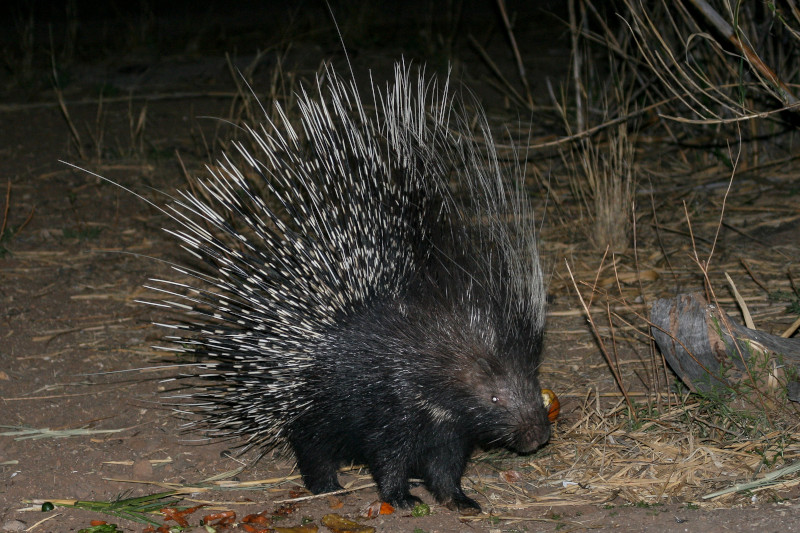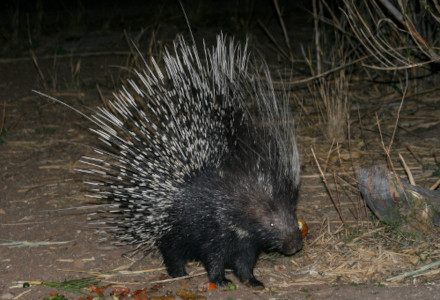
Cape Porcupine Facts
- This well-defended creation of evolution most frequently goes by the somewhat deceptive common name of the Cape Porcupine. The animal does have a few other titles, though. Those include South African porcupine and Cape Crested porcupine.
- Within the scientific community, however, it’s likely better known by its official name. Unfortunately, like many such terms, it’s quite hard for the layperson to pronounce. That’s true since it holds the tongue-twisting formal name of Hystrix africaeaustralis.
- It received this difficult official moniker due to the efforts of Wilhelm Peters. The respected German naturalist accomplished the first formal acknowledgement of it as a separate and distinct species. He managed that scientifically noteworthy deed in 1852.
- Regardless of which of these terms one chooses to use, the animal remains an impressive creature. That’s because it’s both the largest rodent on the continent to which it’s native, and also the largest of all known species of porcupine on earth.
- For now, at least, the amazing Cape Porcupine seems to be maintaining a population base that’s both stable and sufficient. This fortunate state further appears to hold true throughout its range. The IUCN therefore presently lists it as Least Concern.
- It nevertheless faces several potential threats to its existence, like most species. Many of these, though not all, stem from the actions of mankind. The intriguing rodent now faces the dual dangers composed of habitat loss and ongoing climate change.
Related Articles
Cape Porcupine Physical Description
The remarkable Cape Porcupine fascinates most individuals fortunate enough to encounter one. It does so for several reasons. Opinions vary, however, on which of these stands out the most. Some argue that it’s the animal’s size, while others refer to its appearance.
Regarding physical size, the fabulous rodent follows a pattern common to many mammals. That’s in the fact that it displays a certain degree of the physiological characteristic of sexual dimorphism. But in its case, this appears in a moderate difference in size.
More specifically, females of the amazing species attain a slightly greater body mass than their male counterparts. Males grow to an average weight equaling approximately 37 lb (16.9 kg). Females, however, reach a mean weight measuring roughly 41 lb (18.4 kg).
Despite the variation in overall mass, both genders attain the same average range of length. From the base of the tail to the head, both sexes average 25 – 32 in (63 – 81 cm). The female thus tends to have a stockier build than males. Exceptional specimens also occur.
It’s likely the daunting spines that cover the majority of the body of the Cape Porcupine that garner the most attention, though. These reach up to 20 in (50 cm) in length. Mixed in with these, the animal also manifests many thicker, sharp quills, measuring up to 12 in (30 cm).
The bristly fur generally presents as either brownish or blackish in color. Free of either spines or quills, the underside also shows a dark fur. The eyes and ears of the rodent develp as relatively small. The short yet powerful legs sport feet with five sharply clawed toes.
- Kingdom: Animalia
- Phylum: Chordata
- Class: Mammalia
- Order: Rodentia
- Family: Hystricidae
- Genus: Hystrix
- Species: H. africaeaustralis
Cape Porcupine Distribution, Habitat, and Ecology
The distinctive Cape Porcupine evolved as native to a moderately expansive portion of the world. That exact zone of habitation doesn’t surprise many people, though. That’s because it developed as endemic to a portion of what’s now the continent of Africa.
There, it inhabits the central to southern sections of the continent. To the south, the animal lives all the way to the tip of the continent, in South Africa. The northern edge of its range roughly extends to Kenya, Uganda, and the Democratic Republic of the Congo.
Fortunately for the animal, it developed as highly adaptable regarding its choice of habitat. this creature therefore lives in a comparatively wide range of ecosystems within its greater overall range. Currently, the sole known exception consists of areas of swampland.
Extremely arid deserts and dense forests hold only marginal, though present, populations, as well. It also thrives across a wide range of altitudes, too. Concentrations of the mammal make their home at heights ranging from sea level to roughly 6,652 ft (2,000 m) above that.
Like its kindred, the Cape Porcupine evolved as omnivorous in nature. It primarily consumes a wide variety of plant material, including bulbs, tubers, roots, fruits, and bark, the latter often in large quantities. Yet it also augments this with insects and small vertebrates.
It mainly functions as nocturnal, preferring to remain in its burrow during the day. Understandably, it has few natural predators, even among larger animals. Compared to other rodents, it’s long-lived, with most individuals averaging a 10-year lifespan in the wild.
Species Sharing Its Range
Check out our other articles on 5 Herbaceous Plants of Georgia, Ribbon Seal, Deception Island, Small Copper, Orange Jewelweed, Mangrove Monitor, Southern Darwin’s Frog

